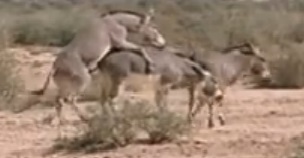Dave Laliberte/Wild African Ass
Horses are perissodactyls (odd-toed ungulates), a group that also includes rhinoceroses and tapirs. The first horses appeared around 56 million years ago, the diversity of which peaked and then dramatically decreased around 12,000 years ago. All went extinct except the Equus (modern horse) genus and today wild horses are found only in parts of Africa and Asia.
 The African wild ass or African wild donkey (Equus africanus) is a wild member of the horse family, Equidae. This species is believed to be the ancestor of the domestic donkey, which is usually placed within the same species. The African wild ass is well suited to desert or semidesert environments, but need to drink at least once every three days. They roam within 18.5 miles from water. The African wild ass can cope with a high dehydration level of 30%, and like other desert-dwellers once it gets access to water it can restore fluid loss in a very short time. Interestingly, they have been reported to drink salty or brackish water. These African wild asses have tough digestive systems, which can break down desert vegetation and extract moisture from food efficiently.
The African wild ass or African wild donkey (Equus africanus) is a wild member of the horse family, Equidae. This species is believed to be the ancestor of the domestic donkey, which is usually placed within the same species. The African wild ass is well suited to desert or semidesert environments, but need to drink at least once every three days. They roam within 18.5 miles from water. The African wild ass can cope with a high dehydration level of 30%, and like other desert-dwellers once it gets access to water it can restore fluid loss in a very short time. Interestingly, they have been reported to drink salty or brackish water. These African wild asses have tough digestive systems, which can break down desert vegetation and extract moisture from food efficiently.
Characteristics
The African wild ass is 6.6 ft long and 12.1 to 14.1 hands (51 to 59 in) tall at the shoulders, with a tail 12-20 in long. It weighs 510-610 lbs.. The short, smooth coat is a light grey to fawn colour, fading quickly to white on the undersides and legs. There is a slender, dark dorsal stripe in all subspecies, while in the Nubian wild ass (E. a. africanus), as well as the domestic donkey, there is a stripe across the shoulder. The African wild ass is the ancestor of all domestic donkeys. The legs of the Somali wild ass (E. a. somaliensis) are horizontally striped with black, resembling those of a zebra. On the nape of the neck, there is a stiff, upright mane, the hairs of which are tipped with black. The ears are large with black margins. The tail terminates with a black brush. The hooves are long, narrow and slender and approximately of the diameter as the legs. They are designed for stability rather than speed. They have large ears which give them an excellent sense of hearing and help in cooling. They have very loud voices which can be heard for over 1.9 miles. This helps them to keep in contact with other asses over the wide spaces of the desert. The species is a grazer, eating mostly grasses and also herbs.
The African wild ass is primarily active in the cooler hours between late afternoon and early morning, seeking shade and shelter amongst the rocky hills during the day. The Somali wild ass is also very agile and nimble-footed, capable of moving quickly across boulder fields and in the mountains. On the flat, it has been recorded reaching speeds of 43 mph. In keeping with these feats, its soles are particularly hard and its hooves grow very quickly. Wild asses can run swiftly, almost as fast as a horse. However, unlike most hoofed mammals, their tendency is to not flee right away from a potentially dangerous situation, but to investigate first before deciding what to do. When they need to, they can defend themselves with kicks from both their front and hind legs.
This animal is hunted for bush meat. Traditional African medicine uses the African Wild Asses' body parts which also contributes to their decline in numbers particularly in Ethiopia and Somalia. The animals must compete with other wildlife and livestock. Agriculture often blocks their ability to get to water sources.
Laws have been enacted in Sudan, Somalia and Ethiopia to protect these animals; however, the laws are difficult to enforce. Reserves have been set up but competition with livestock and farmers as well as poachers still take a toll.
In captivity there are about 150 individual Somali wild asses living in zoos around the globe. Thirty-six were born at Zoo Basel ![]() . This species's breeding program started with Basel's first Somali wild asses in 1970 and the first birth in 1972. Zoo Basel manages the European studbook for the Somali wild ass and coordinates the European Endangered Species Programme (EEP). All European and American wild donkeys are either descendants of the original group at Zoo Basel or of 12 others that came from the Yotvata Hai-Bar Nature Reserve in Israel
. This species's breeding program started with Basel's first Somali wild asses in 1970 and the first birth in 1972. Zoo Basel manages the European studbook for the Somali wild ass and coordinates the European Endangered Species Programme (EEP). All European and American wild donkeys are either descendants of the original group at Zoo Basel or of 12 others that came from the Yotvata Hai-Bar Nature Reserve in Israel ![]() in 1972.
in 1972.
For More Information:
Wildscreen ArkiveEdge Revolutionarily Distinct and Globally Endangered
African wild ass or African wild donkey

